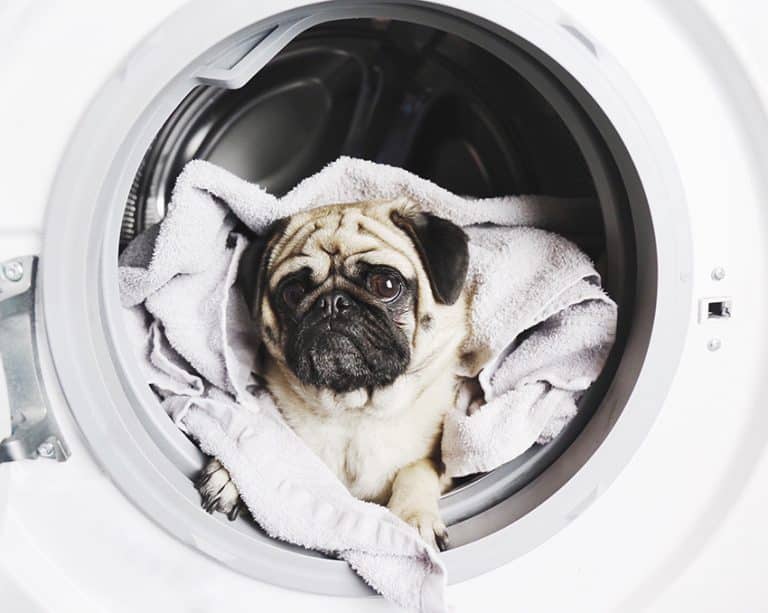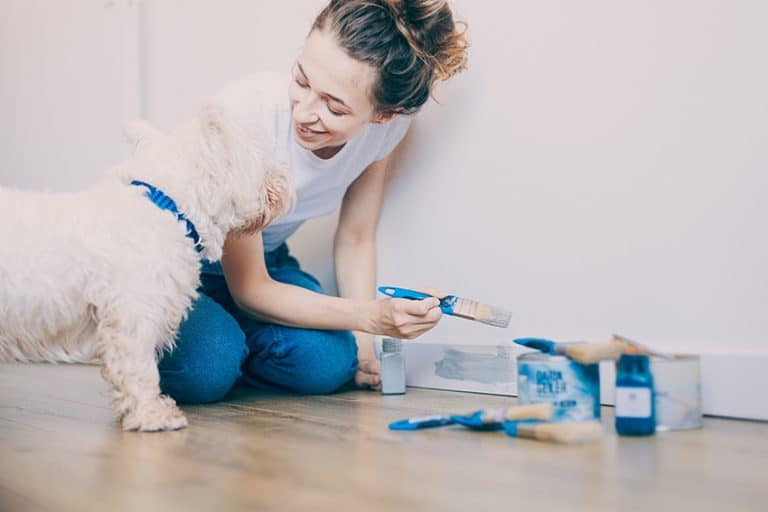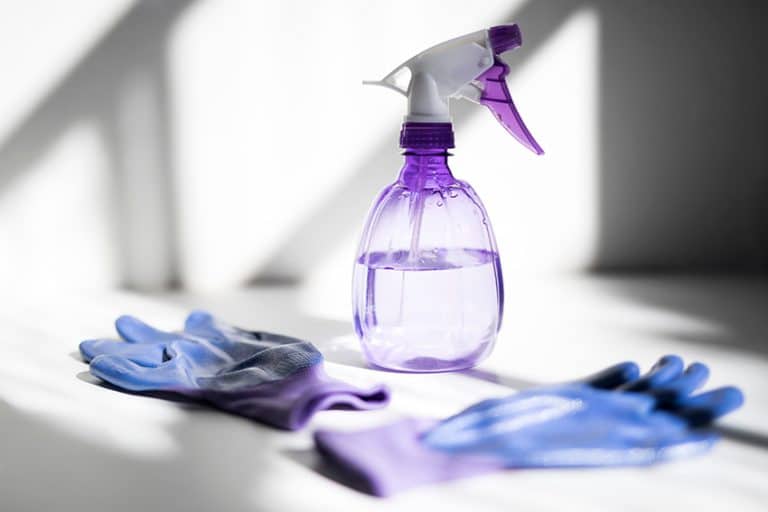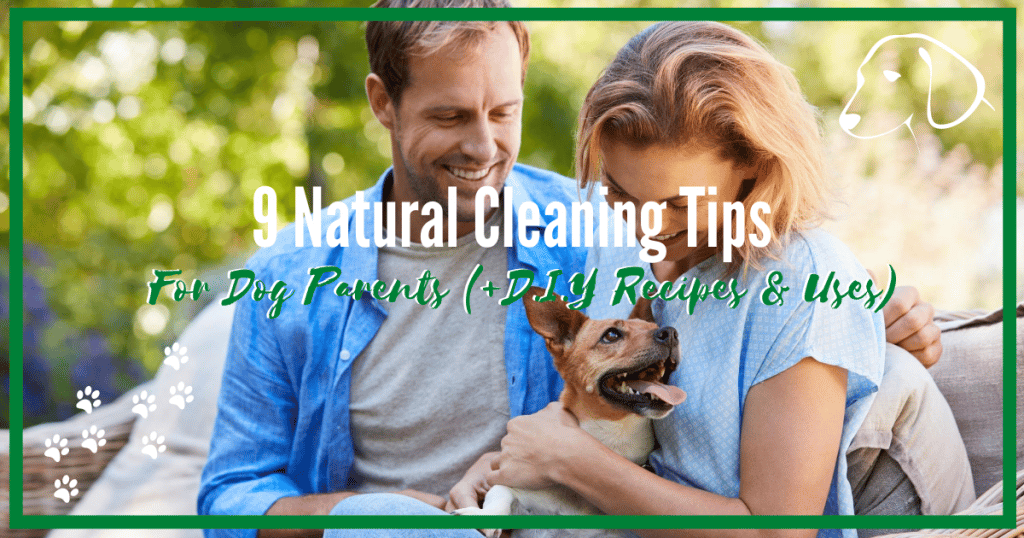But first, let’s talk about cleaning products that you should avoid:
Cleaning Products That Are Harmful to Dogs

- Toilet bowl cleaners
- Air fresheners
- Floor cleaners
- Fabric softeners
- Multi-surface cleaners
- Blistering around the mouth or other mucous membranes
- Raw skin or rashes
- Hair loss
- Pawing at the eyes or mouth
- Inappetance
- Lethargy
Natural Dog-Friendly Cleaning Recipes
Baking Soda as a Cleanser and Deoderizer

Vinegar and Water for General Cleaning

In addition to floors, the vinegar-water solution is an effective general cleaner. Put some in a squirt bottle to clean your counters, the dog toys, the litter box, and other household items. You can safely store the mixture in between cleanings.
Lemon Juice and Water for Glass Surfaces and Windows

For glass cooktops, mirrors, and windows, try combining fresh lemon juice with twice as much water. Use a spray bottle to apply to your glass surfaces for cleaning. If there’s excess dirt or buildup, you can mix in a drop of dish soap for extra cleansing power. Once you spray the solution, wipe the surface with a dry towel. Then go back over with a damp cloth.
Pet-Safe Essential Oils for Fresh Laundry

- 1 cup white vinegar
- 15 drops lavender essential oil
- 15 drops lemon essential oil
Recipes to for Deep Cleaning

Oven Cleaner
Homemade Dishwasher Detergent
- 1 Tablespoon of Borax
- 3 Tablespoons of baking soda
- 2 drops of a citrus-based essential oil
Shower Head Cleaner
Burnt Saucepans
Fridge Cleanser
Natural Grease-Cutting Cleaner
- ½ cup vinegar
- ¼ cup baking soda
- 1 gallon hot water
- 1 teaspoon natural liquid soap
- 5 drops lemon or orange essential oil (you can also use lemon juice)
Sink and Tub Cleaner
- 1/3 cup borax
- 1/3 cup baking soda
- 10 drops lavender essential oil
- 1 tsp natural liquid soap (optional)
- 5 drops lemon or orange essential oil (you can also use lemon juice)
Appliance Cleaner and Polish
Natural Mold and Mildew Remover
- 1 cup borax
- 2 cups of water
- 1/2 tsp tea tree oil
Cleaning Solutions for Pet Stains

Urine
Carpet Stains
Orange Drink or Vinegar + Water for Toilet Bowls

- ¾ cup borax
- 1 cup white vinegar
- 10 drops lavender essential oil
- 5 drops lemon essential oil
Vinegar to Cut Paint Fumes

Natural Deodorizer

- ¼ cup vodka
- 1 cup of water
- 15 drops of lavender essential oil
NEVER apply essential oils directly to your pup’s skin or fur. Some varieties can be highly toxic.
How Do You Keep Your Home Clean and Dog-Safe?
As a dog parent, maintaining a clean and comfortable home environment can be challenging at times, but it is not impossible. Here are few tips that would help you keeping your home safe:
- Regular Dog Grooming: One of the best ways to keep your home clean is to groom your dog regularly. Brushing your dog helps reduce shedding, while frequent baths with a gentle, natural pet shampoo can help control dander. For those with long-haired breeds, regular trips to a professional groomer might be a good idea.
- Invest in a Quality Vacuum: Vacuums designed for pet hair can be a lifesaver. Look for one with strong suction and a HEPA filter to effectively capture pet dander.
- Choose Pet-Friendly Furniture: Opt for furniture materials that are easy to clean, such as leather or faux-leather. Alternatively, use washable furniture covers that can catch pet hair and be easily cleaned.
- Dog-Proof Bedding: If your dog is allowed on your bed, consider using dog proof covers and comforters made from durable, washable materials that resist dog hair. Additionally, placing a washable throw blanket where your dog usually sleeps can help contain the hair and dirt, making cleaning easier.
- Regular Floor Cleaning: For hard floors, a microfiber mop can efficiently pick up pet hair. Carpets may require a more powerful vacuum or a carpet cleaner for deeper cleaning.
- Make Lint Rollers Your Best Friend: Lint rollers are great for a quick clean-up of pet hair on furniture, clothes, and other surfaces.
- Wash Bedding and Toys Regularly: Keep your dog’s bedding and toys clean by washing them regularly. Consider using natural, fragrance-free laundry detergents to avoid irritating your pet’s skin.
- Paw Cleaning: Keep a towel by the door to wipe your dog’s paws after walks. This simple habit can greatly reduce the amount of dirt tracked into your home.
- Regular Vet Check-Ups: Regular health check-ups are vital to ensure your dog is free from parasites and illnesses that could lead to messes in your home.
- Designate a Feeding Area: Use a mat under your dog’s food and water dishes to catch spills. You can easily clean or replace this mat as needed.
- Consider an Air Purifier: To remove dander and allergens from your home, an air purifier can be a worthwhile investment.
- Robot Vacuum: For daily maintenance, consider a robot vacuum. It can roam your home picking up pet hair, giving you one less chore to worry about.
These strategies will not only help maintain a cleaner home but also create a healthier environment for you and your furry friend. Remember, every dog is unique, so you might need to experiment and see which tactics work best for your household. Consistency is key, and the extra effort is always worth the joy of having a dog in your home.
The Final Woof



